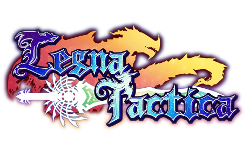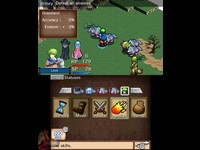|
|

|
PLATFORM
|
3DS
|
BATTLE SYSTEM
|

|
INTERACTION
|

|
ORIGINALITY
|

|
STORY
|

|
MUSIC & SOUND
|

|
VISUALS
|

|
CHALLENGE
|
Easy
|
COMPLETION TIME
|
Less than 20 Hours
|
|
OVERALL

|
+ Very forgiving learning curve
+ Solidly enjoyable music score
- Combat lacks features to set it apart
- Finds groove just as it outstays welcome
|
Click here for scoring definitions
|
|
|
There's something to be said for the longevity of classics. Clearly, there's a reason why Squaresoft's Final Fantasy Tactics, for example, is still considered a high-water mark of the genre, even today, twenty years after its original release. It's nearly impossible to completely avoid comparisons to these genre juggernauts when talking about a newer entry like Hit-Point's Legna Tactica — fair enough. What's telling is the way that the game reaches for the bar set by its predecessors and falls just short, despite being released decades later in some cases. As it stands, Legna Tactica struggles to move past novice-level tactical gameplay, failing to measure up to the heavyweights. Enthusiasts of intricate, well thought out battles won't find much to cut their teeth on, as the game gets stuck in a prosaic limbo of simple skirmishes for much of its playtime. That said, it isn't a completely lost cause, as the developers have clearly put some effort into presenting a story that's, at its best, bordering on interesting.
The story centers around a trio of orphans in the kingdom of Legna. Having grown up together at the orphanage, Leck, Miana, and Astar are young recruits in the Azure Hawk Brigade, one of the kingdom's twin armies. Both Leck and Astar strive to rid the world of violence, having both become orphaned due to war. Perplexingly, both are of the conviction that the only way to bring an end to the fighting is to participate in as many battles as possible, in the process becoming skilled soldiers and growing as powerful as possible. This apparent contradiction is the driving force of much of the game's rather cookie-cutter first half. Astar leaves the group to join the nefariously-named Crimson Wolf Brigade, while Leck and Miana are taken under the wing of the legendary knight General Varrius.
For the next nineteen-or-so hours, a rather straightforward story about the military clashes of three nations unfolds, as the hostile country Izmoot picks fights with all its neighbors. Leck and company are joined by a host of other characters who've all seemingly taken a turn through the random name generator. There's the wizard Rogwalk, a young mage named Tetolla, and the lancer Evie, to name a few. While not particularly groundbreaking in its character classes — there's the obligatory archer, bard, thief, and gun-wielder — most of the characters feature heavily in the story, get plenty of time during the narrative sections to become familiar cogs in the group's machinery. Only a small handful of characters feel tacked on, particularly the ones that aren't as useful in battle.
 What this game Lecks in originality, it makes up for in sea-conch-style enemy color pallettes.
What this game Lecks in originality, it makes up for in sea-conch-style enemy color pallettes.
|
|
Combat scenarios come in two forms: key story encounters and side-quest missions designed for grinding that have players revisit already-completed battlefields for repeat skirmishes. Calling the battle system "serviceable" is perhaps overlooking its shortcomings; a few extra layers of polish would have done Legna Tactica a world of good, and battles themselves are light on features. At the start of each encounter, players must choose their battle party and starting positions. The irony is that these choices amount to nothing; until late in the game, battles typically have enough slots to accommodate the whole squad, and the starting positions are all adjacent to each other, every single time. Being pressed to select combatants carefully or be able to spread out over the map would have added a lot more planning to each conflict. The game doesn't even allow for an inspection of the battlefield until after unit positions are locked in. Where's the Tactica in that?
Early battles follow the bog-standard pattern of move behind enemy, perform attack, watch enemy circle around and attack own character from behind, repeat. A big oversight is that terrain sadly plays only a very minimal role in combat, mainly as a hindrance to swift movement. Many more nuances could have been implemented to add variety as the game wears on. Gaining advantages for high ground, terrain that slows units, or environmental hazards all would have been welcome additions. As battles are won, characters earn experience and level up their base stats to get stronger, increase magic defense, etc. Certain battles also award Proficiency Points, which are used to unlock special skills and passive abilities. Each character has a unique skill tree of sorts, with nodes that can be upgraded with additional points, in some cases many times over. However, Proficiency Points are only awarded at certain points throughout the game, and there's no way to know ahead of time which story mission will net points.
As basic as these aspects of combat are, it wouldn't be accurate to call it entirely devoid of enjoyment. Especially during the late game, the scope of battles enlarges to include sizeable numbers of enemies to vanquish, which is a lot more fun than the early small-scale clashes. Some encounters feature a boss, or provide an alternative victory condition of taking out one specific enemy leader to end the battle. Unlike similar games, such as the Fire Emblem series, there is no permadeath; characters who fall in battle can be revived via items or magic, or will regain consciousness automatically after the encounter is won. The difficulty curve is extremely forgiving; throughout the entire campaign, I never once lost a single encounter. Sprinkled throughout the kingdoms are towns where the party can visit shops between bouts to purchase better gear, and taverns to pick up a few side quests. Some useful items also lie scattered around on battle maps, and can be picked up by a character ending a turn on their tiles prior to the battle ending.
 Character portraits add flavor where their word-scramble names don't.
Character portraits add flavor where their word-scramble names don't.
|
|
In the graphics department, Legna Tactica is a somewhat mixed bag, though not without at least a few feathers in its cap. Locations visited throughout the campaign, like the above-mentioned battlefields, are too one-note and no-frills to make much of an impression. It's difficult to believe that actual throne rooms ever consisted entirely of unadorned floor-to-ceiling exposed brick, with no banners or decorations of any kind. Battle animations, like magic spells for example, do the job but are nothing to write home about. The large character portraits during conversation were quite enjoyable however, with several key expressions for each main cast member.
The game's musical score was more of a highlight, with well-composed tunes that fit the mold of some of the era's most prominent RPG soundtracks to a T. From the snappy overworld theme to the action-oriented battle music, each part of the soundtrack was easy on the ears and added a good bit of character to the game. Though there weren't a ton of individual songs, they seem to pay homage and feel influenced by genre greats like Nobuo Uematsu. Some tracks accompany certain story beats, like moments of impending danger, broken up by sudden comedic relief. If anything, the sudden switch of songs within a narrative scene when the mood shifts could sometimes be a little jarring, since there don't seem to be actual pieces written for specific scenes. But overall, the score would stand proudly with any number of 16-bit instrumental soundtracks.
If even just a few more features had been implemented into Legna Tactica, I would find myself singing a different song at the end of this review. It is by no means a poor effort, but the main element RPGamers will expect from a TRPG — the tactics promised in the actual title — just never feel very engaging. By the time the scope of battles offers an enjoyable challenge, the game is already nearing its end and fatigue is setting in; it's too little, too late. Narrative, graphics, and music all clock in somewhere around average, with some facets, like the soundtrack, having a slight edge over others. As budget titles go, players can do much worse. Legna Tactica may satisfy some bite-size appetites, but don't expect it to scratch any Final Fantasy Tactics-sized itches.
Review Archives
|









